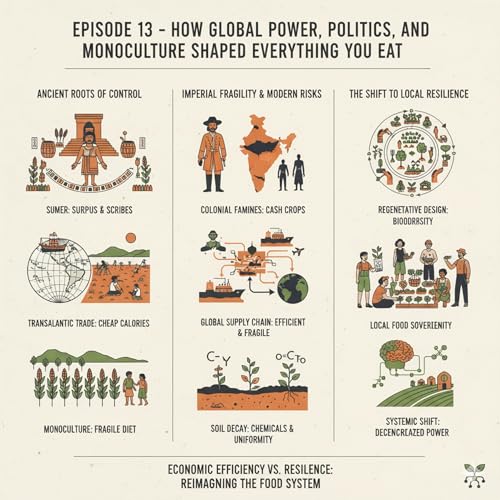
Episode 13 - How Global Power, Politics, and Monoculture Shaped Everything You Eat
カートのアイテムが多すぎます
カートに追加できませんでした。
ウィッシュリストに追加できませんでした。
ほしい物リストの削除に失敗しました。
ポッドキャストのフォローに失敗しました
ポッドキャストのフォロー解除に失敗しました
-
ナレーター:
-
著者:
このコンテンツについて
This episode traces the history of the global food system, revealing how it was shaped by political power, centralized control, and the inherent risks of agricultural uniformity. The foundations of this system extend back to the earliest agricultural surpluses in Sumer, where the abundance of beer and grain was immediately managed by scribes and a political elite, establishing the first forms of centralized control and hierarchy. This centralized structure continued over centuries, with the Transatlantic slave trade accelerating the commodification of cheap calories like sugar, establishing an economic model designed for large-scale production and profit. However, the shift to large-scale, specialized production inevitably introduced fragility, replacing the diverse hunter-gatherer diet with a monoculture dependent on a few genetically similar crops.
This specialization created a vulnerability to environmental shocks, making local famines a systemic feature of early settled life, which was then compounded by later colonial policies. Under imperial control, food systems were optimized for extracting cash crops, transforming local resilience into dependence on distant markets. This structural weakness persists today: the global food system is incredibly efficient but built on a fragile global supply chain that is highly susceptible to disruption from political conflict or climate change. Furthermore, modern agricultural practices continue the specialization trend by relying on chemical inputs and genetic uniformity, which severely damages the resilience of the soil and undermines long-term food security.
The episode concludes that the core problem is one of systemic design, where economic efficiency is prioritized over environmental and local resilience. Addressing the fragility and unsustainability of the current system requires a fundamental shift in focus, moving away from centralized, homogenized production. The solution lies in building local resilience, promoting biodiversity, and adopting regenerative practices that treat the soil as a living ecosystem, countering centuries of centralized control with decentralized, community-level strength.


